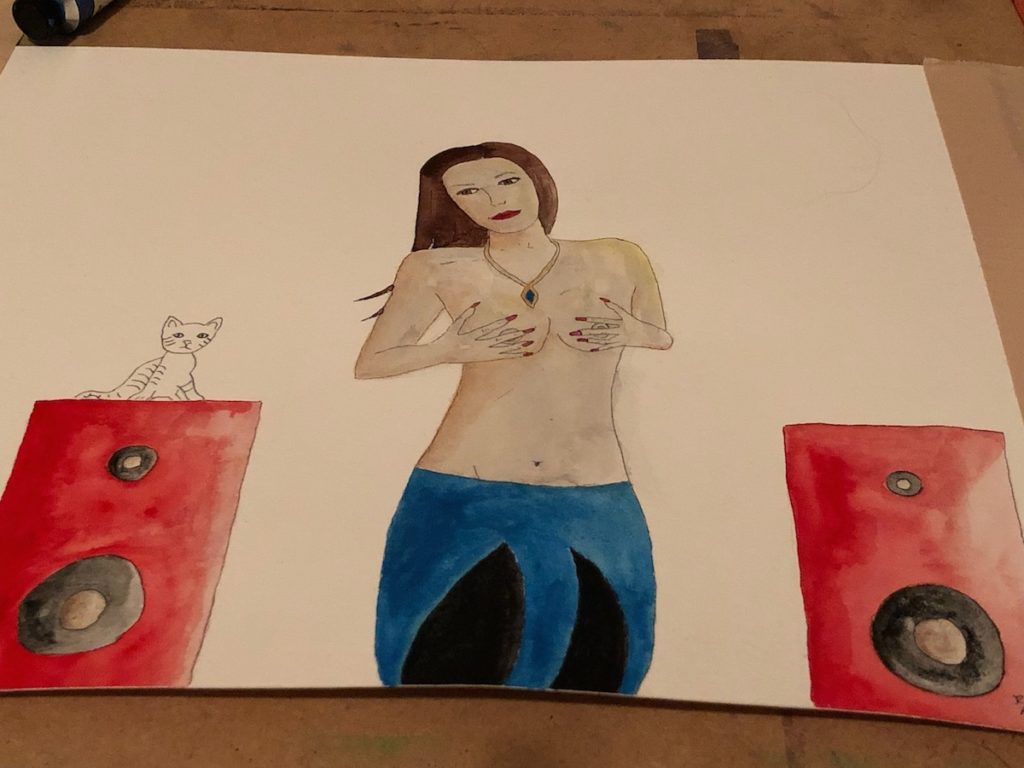I rarely use soap with my watercolor brushes. Usually when we paint with watercolors, using two jars does the trick.
I have two Kimchi jars that I use for my watercolor brushes. The first one is for the initial rinse and the second one is for the second rinse.
With plain old watercolors, water alone does the trick. Just be sure to rinse them in the jars really well.
I swirl them around for 30 seconds in the first jar then 20 seconds in the other before switching to a different color. That way, I don’t leave traces of the first color onto the second color.
However, I also use gouache and as much as I love gouache, it doesn’t always rinse as cleanly as watercolors do.
Exhibit A. Otherwise would have been a really cute painting of Roxy. Now, she looks like a zombie. Totally ruined a good concept. Because you know why? I used gouache for the speakers and failed to rinse the black well enough.

There’s no saving this watercolor painting without turning it super muddy. So, it will go in the trash. Bummer, but it happens.
Yet, you really don’t want it to happen. This was the first time in my life drawing a kitten, and it turned out super cute.
Do I really have to throw this painting out?
Yes. Look at her skin. It looks awful because I still have traces of the gouache.
How to clean watercolor brushes
So now that we’ve covered why you should occasionally clean your watercolor brushes, let’s now cover how to clean them. And no, I’m not getting a penny from Dawn. So I’m saying this without an endorsement.
We buy Dawn soap because it’s the type of soap scientists use to clean animals when there’s an oil spill. If it’s gentle enough to save animal lives, it’s more than likely gentle enough for your watercolor brushes.
Note that I still water it down. I pour one drop, not one squeeze, but one drop of Dawn soap into a Kimchi jar and add cool water. It suds really well.
Then I vigorously stir the brush in that water for about 30 seconds.
Afterwards, I rinse the brush really well with cool water. You want to get the soap totally out of the brush.
To test if it worked, paint with water on your watercolor journal. It should be totally clear, without any suds either.
I don’t like to clean my brushes too often. Watercolor brushes are made for water. Strong soap will ruin your brush.
So will hot water.
Cleaning too many times will ruin the natural oils in your brush. It’s like when you shampoo too much. You don’t want to do that to your hair. And you don’t want to do that to your brushes.
You can always test to see if you need to clean your brushes with soap by painting with nothing but water in your watercolor journal. You’ll know right away.
Had I remembered to do this, I would have saved the painting above.
But like I promised you, I’ll never lie to you. You’ll see my greatest creations. But I’ll also show you when I’ve done something stupid so you can learn not to do that too.
Update March 10, 2023 – I wrote this article back in 2019. Since then, I’ve very rarely had to use Dawn soap.
When you paint with gouache, just make sure you swirl your brush in the jars with water very well. The way to test is simple – swirl well in both your primary and secondary jars. Then take some plain old water and paint the water onto your watercolor journal.
If it’s clear, you’re good. If it’s not clear, you need to swirl longer. I’m reluctant to advise using soap unless you absolutely have to. I’m pretty sure it’s not exactly good for the brush.
I still own the same brushes that I did when I initially wrote this article. And yes, they’re still fine! I very rarely use soap – maybe three or four times, tops. It’s when I was really caking on the gouache for effect.
